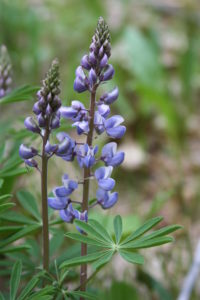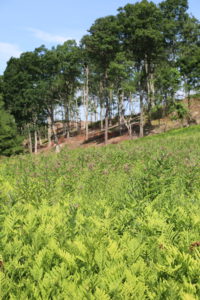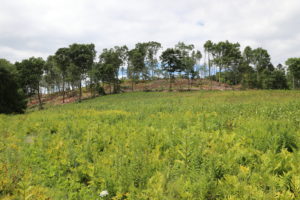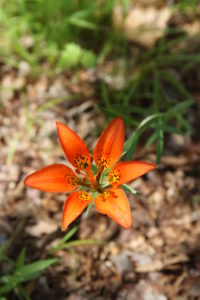Restoring a Pitch Pine-Oak Upland Forest at Norcross Wildlife Sanctuary
Written by: Dan Wilder, Director of Wildlife Ecology, Norcross Wildlife Foundation
Norcross Wildlife Foundation is located in south-central Massachusetts and north-central Connecticut and stewards 8000+ acres of land in an effort to protect, enhance and expand habitat for wildlife. 8000 acres seems like a lot of land at first (it is) but from a wildlife habitat point of view it is also a small section of a much larger region. As stewards of the land, we are constantly asking ourselves what can we really do to support our mission in the most effective way? Should our focus be invasive species management, lawn conversions, habitat enhancements… The answer is rarely straightforward and always involves prioritization of goals and resources.
One of the lenses we use to prioritize our work is to examine where the rare species of our region make their homes. It was surprising when we first learned that about half of the terrestrial species on the Massachusetts endangered species list make their homes in fire-influenced habitats. Numerous rare plant species thrive in these landscapes where they support various rare lepidoptera, birds, amphibians and mammals. Habitat loss is the main driver of biodiversity loss and many of these fire-influenced habitats have already been lost due to development. Add a long history of fire suppression in the region and it’s no surprise that so many fire-influenced species show up on endangered, rare, and threatened lists.
 This thought process came to a head when we discovered a series of cryptic pine barrens on Norcross lands. A cryptic pine barren is a pine barren that is being overtaken by mesophytic (medium moisture) species due to a lack of disturbance (i.e. fire). What we saw on these sites were pitch pines and oaks being overshadowed by species such as red maple and white pine. When fire is allowed to occur in such a place it will kill off (or at least reset) species that are not adapted to fire. If the forest burns, pitch pine, oak, and a variety of understory shrubs and forbs will flourish. However, when fire is suppressed those fire-adapted species are quickly overrun by the faster growing mesophytic species. Though red maple and white pine are valuable plants, they are common and widespread, while the pine barren species are not. In a thriving pine barren, rare or threatened species such as sundial lupine (Lupinus perennis), eastern whip-poor-will (Antrostomus vociferus), and eastern box turtles (Terrapene carolina) can thrive. When we asked ourselves what we could do to have substantial positive effects on wildlife conservation in our region, restoring these ecosystems was an obvious priority.
This thought process came to a head when we discovered a series of cryptic pine barrens on Norcross lands. A cryptic pine barren is a pine barren that is being overtaken by mesophytic (medium moisture) species due to a lack of disturbance (i.e. fire). What we saw on these sites were pitch pines and oaks being overshadowed by species such as red maple and white pine. When fire is allowed to occur in such a place it will kill off (or at least reset) species that are not adapted to fire. If the forest burns, pitch pine, oak, and a variety of understory shrubs and forbs will flourish. However, when fire is suppressed those fire-adapted species are quickly overrun by the faster growing mesophytic species. Though red maple and white pine are valuable plants, they are common and widespread, while the pine barren species are not. In a thriving pine barren, rare or threatened species such as sundial lupine (Lupinus perennis), eastern whip-poor-will (Antrostomus vociferus), and eastern box turtles (Terrapene carolina) can thrive. When we asked ourselves what we could do to have substantial positive effects on wildlife conservation in our region, restoring these ecosystems was an obvious priority.
 So how does one restore a fire-influenced pitch pine-oak upland forest? As exciting as lighting a fire and walking away may sound it is not the recommended method. In an area that has not burned in a long time the fuel load needs to be managed. Too high of a fuel load means that a fire burns too hot leading to the loss of all species. When fires are allowed to burn on a regular basis the fuel loads stay low, and the resulting fires are cooler allowing fire- adapted species to proliferate. As this site had not burned in recent years, we have a lot of work in front of us before we set any fires. Our first step was to reach out to folks who know fire ecology well. MassWildlife’s Natural Heritage and Endangered Species folks were happy to get involved and have been weighing in on the process since day one. Our first major step was some substantial forestry work. We reached out to a consulting forester who specializes in habitat forestry, and they helped us to find a logger who would be willing to work with our goals. Our logging goals were to remove just about every tree that wasn’t either a pitch pine or an oak. Additionally, we wanted whole-tree harvests and we encouraged some amount of soil disturbance.
So how does one restore a fire-influenced pitch pine-oak upland forest? As exciting as lighting a fire and walking away may sound it is not the recommended method. In an area that has not burned in a long time the fuel load needs to be managed. Too high of a fuel load means that a fire burns too hot leading to the loss of all species. When fires are allowed to burn on a regular basis the fuel loads stay low, and the resulting fires are cooler allowing fire- adapted species to proliferate. As this site had not burned in recent years, we have a lot of work in front of us before we set any fires. Our first step was to reach out to folks who know fire ecology well. MassWildlife’s Natural Heritage and Endangered Species folks were happy to get involved and have been weighing in on the process since day one. Our first major step was some substantial forestry work. We reached out to a consulting forester who specializes in habitat forestry, and they helped us to find a logger who would be willing to work with our goals. Our logging goals were to remove just about every tree that wasn’t either a pitch pine or an oak. Additionally, we wanted whole-tree harvests and we encouraged some amount of soil disturbance.
 The purpose of the whole tree harvest was to remove as much of the material from the site as possible, this is unlike most of my previous work (where slash and tops are left to decompose) but was an important part of this process. Barrens ecosystems are not rich in nutrients and the species we were trying to encourage were well-adapted to low-nutrient sites while the mesophytic species that we were hoping to remove thrived in high-nutrient sites. The removal of all of those excess nutrients in the form of whole trees was one step in the restoration process and helped to offer a competitive edge to the barrens species.
The purpose of the whole tree harvest was to remove as much of the material from the site as possible, this is unlike most of my previous work (where slash and tops are left to decompose) but was an important part of this process. Barrens ecosystems are not rich in nutrients and the species we were trying to encourage were well-adapted to low-nutrient sites while the mesophytic species that we were hoping to remove thrived in high-nutrient sites. The removal of all of those excess nutrients in the form of whole trees was one step in the restoration process and helped to offer a competitive edge to the barrens species.
 Another amazing trait of these ecosystems, in particular the plant species that thrive in them, is that their seeds often remain viable in the soil for many (sometimes 100+) years waiting for the next fire. The soils disturbance was accomplished by dragging out the whole trees, thus exposing the seed bank buried under the duff layer. There was a known population of sundial lupine on site in the past but it has not been seen for 15+ years. For lupine, 15 years is nothing and we are hopeful that the seeds will germinate for us as the process continues. The logging work flipped the ecosystem from one with a dense overstory and very little understory to a much more open canopy which will allow the development of a dense and unique understory with species such as hillside blueberry (Vaccinium pallidum), New Jersey tea (Ceanothus americanus), and wood lily (Lilium philadelphicum) to proliferate. We found our first wood lily earlier this year and our first New Jersey tea appeared between the first and last drafts of this article!
Another amazing trait of these ecosystems, in particular the plant species that thrive in them, is that their seeds often remain viable in the soil for many (sometimes 100+) years waiting for the next fire. The soils disturbance was accomplished by dragging out the whole trees, thus exposing the seed bank buried under the duff layer. There was a known population of sundial lupine on site in the past but it has not been seen for 15+ years. For lupine, 15 years is nothing and we are hopeful that the seeds will germinate for us as the process continues. The logging work flipped the ecosystem from one with a dense overstory and very little understory to a much more open canopy which will allow the development of a dense and unique understory with species such as hillside blueberry (Vaccinium pallidum), New Jersey tea (Ceanothus americanus), and wood lily (Lilium philadelphicum) to proliferate. We found our first wood lily earlier this year and our first New Jersey tea appeared between the first and last drafts of this article!
Invasive species management has been an important part of the process. On site are many of the common invasive species of the region and our work has set the stage for seed germination. The invasive species management will help to ensure that we see lupine emerging and not bittersweet. Invasive species management has been ongoing for the past year and we expect at least three more years of regular invasive species management before we can shift from the removal stage to the upkeep and management stage.
Biological surveys have begun and will continue indefinitely. Knowing what is emerging on site will give us the information we need to determine whether we should be introducing additional species or if we can simply allow nature to run its course. Additionally, we want to keep track of the rare species on site and will be working with Natural Heritage to ensure those species thrive.
This site is a work in progress and though we’ve made some amazing strides, we still have a long way to go. There are a series of old semi-managed pastures on site that will be the focus of the next stage of the project. Our goal is to convert these pastures into dry grasslands dominated by little bluestem (Schizachyrium scoparium) but other than some invasive species management that work has not yet begun. We expect to introduce fire to the ecosystem in 2024. Keep an eye out for a Norcross Wildlife Foundation/ Ecological Landscape Alliance Ecotour of the site at some future point (not yet planned).

